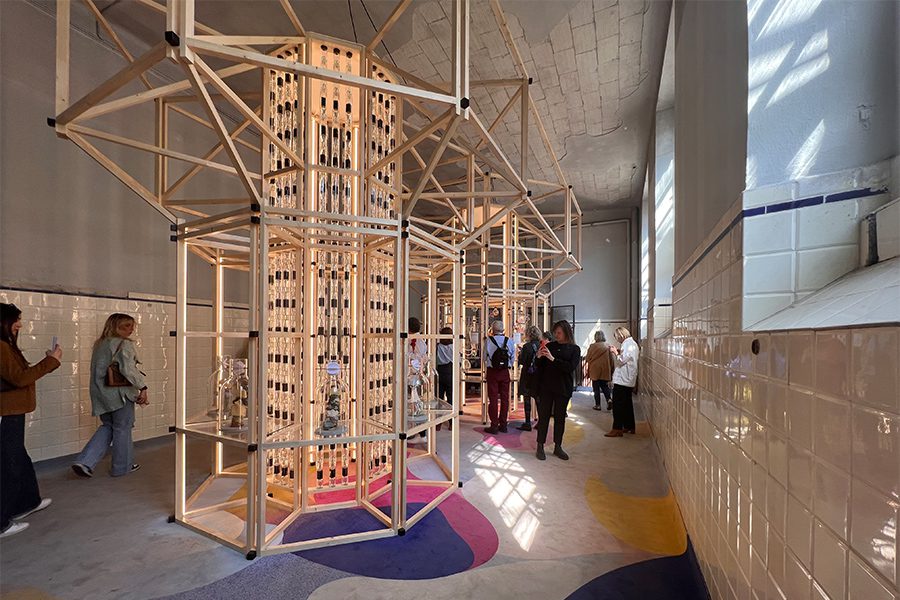More than 2,000 brands exhibited at the 61st edition of Salone del Mobile in Milan, which drew more than 307,000 attendees from around the world. Boundary-pushing exhibitions and installations brought together renowned designers and brands including Philippe Starck and Dior; Kettal and Patricia Urquiola; Loro Piana and Christián Mohaded, and more.
Below, Davidson Hospitality Group creative director Staci Patton shares some of her favorite exhibitions and her trend takeaways from the show.
Integrated technology elevates design

The Experience a Life Extraordinary installation from Moooi
Brand Moooi bridged the gap between the physical and digital worlds with “Experience a Life Extraordinary” at Salone dei Tessuti. To begin, guests used a QR code to take a personality quiz, the results of which were used to generate a bespoke fragrance by EveryHuman, an AI-powered technology. While guests waited for their unique concoction, immersive rooms offered a chance at exploration with furniture, textiles, and otherwordly music.
DWA Design Studio’s “Les Expériences Immobiles” highlighted the growing fragrance brand, Les Eaux Primordiales. The installation, inspired by laboratory towers, was a fragrant visual feast with glass vials, mechanical fans, and scent-infused ceramics by Natascia Fenoglio that immersed guests in a multi-dimensional experience. “These spaces appealed to the senses but, dare we say, the supported technology in these installations [reveal] there is a sixth sense to design,” says Patton.
Fashion brands expand into furnishings

Giorgio Armani’s Casa collection
“As the luxury market grows so have customers’ desires to expand their loyalty to luxury into their homes,” says Patton. Spanish brand Loewe took an unexpected approach to transform an everyday object into a masterpiece. Under the creative direction of Jonathan Anderson, the brand showcased 30 stick chairs with weaving techniques in different materials such as raffia, thermofoil metallics, leather, and furry felt-like textiles using bold color.
Hermes took a bold step to strip away the noise and embrace materiality. The fashion house showed its new creations with exposed geometric iron frameworks and concrete backdrops asserting strength through subtraction with effortless ease. Another luxury staple, Giorgio Armani opened its Milan Palazzo Orsini headquarters to the public for the first time for Armani/Casa, presenting the Casa collection in the palazzo’s garden with a focus on the outdoor collection, ceramics, and a mother of pearl desk and dresser.
At Euroluce, lighting trends away from Art Deco
View this post on Instagram
“Illumination was frequently accompanied by texture, natural materials, and less metal,” says Patton, noting that the longstanding affinity for Art Deco has given way to interesting material combination lamps like the marble-and-glass Crossta table lamp, designed by Sid&Sign Studio for Dimarmo. Agglomerati, a London-based studio created “Objects of Permanence” functional art and lighting sculptural objects in stone for Alcova. Others standouts were Preciosa’s mega exhibit showcasing Crystal Grid, a customizable modular lighting concept featuring crystals and bronze accents, and fashion-turned-object designer Elisa Uberti‘s “Primitive Island,” amorphous fixtures made of clay that paid homage to Africa’s landscapes.
Color makes a comeback

L’Appartamento by Artemest
“If there is one thing about this year’s design week to make note of, is the poetically evident fact that color is in high demand,” says Patton, a trend signaled when Pantone named 18-1750 Viva Magenta 2023’s Color of Year and embodied in Artemest‘s L’Appartamento installation within a 1930s villa. Six design firms collaborated on the project, each crafting a single room. “The Artemest L’Appartemento felt like London, Dubai, Miami, Dublin, Houston, and Paris seamlessly found their way into an apartment that is proudly artistic yet sophisticatedly tailored in such a perfect Milanese fashion,” says Patton. Guests could not only experience the colorful juxtapositions in person, but could also scan a QR code to shop the apartment. Over at Alcova, the studio collaborated with LeoLux design furniture brand and Studio Truly Truly to install “Rhythms,” a moving citron velvet upholstered sculpture that rose and fell, revealing new seating and casegood piece vignettes.
Organic forms meet materials

Part of the Neo-Vanity collection by Kiki Goti
Emerging artists challenged the status quo by experimenting with shapes and materials. Greek architect Kiki Goti’s Pop Art-style range of homewares (spanning lighting to mirrors), showcased her inventive use of materials including painted foam, metallics, and concreate. In another hall, designer Jonathan Bocca created “Corallo Lamp,” “Giraffa Lamp,” and “Iceberg” inspired by the artist’s own dreams. “You felt it when you approached his objects, [seeing] a gritty technique, bold color saturation, and trippy forms,” says Patton.
Irthi’s installation at Via Cesare Correnti titled “Echoes of Alchemy,” was a collaboration to preserve, engage, elevate, and empower the art of crafts and their Emirati creator. Throughout the rooms of the villa, natural earthen colors set a soft stage for the tables, which displayed building blocks topped with materials used in the creation of various objects.



